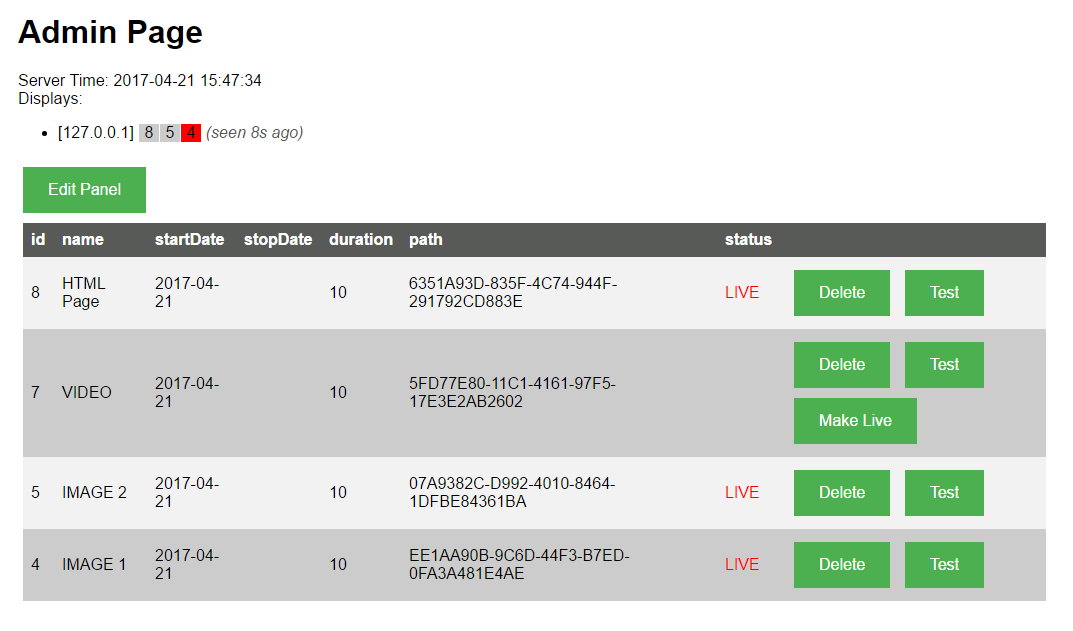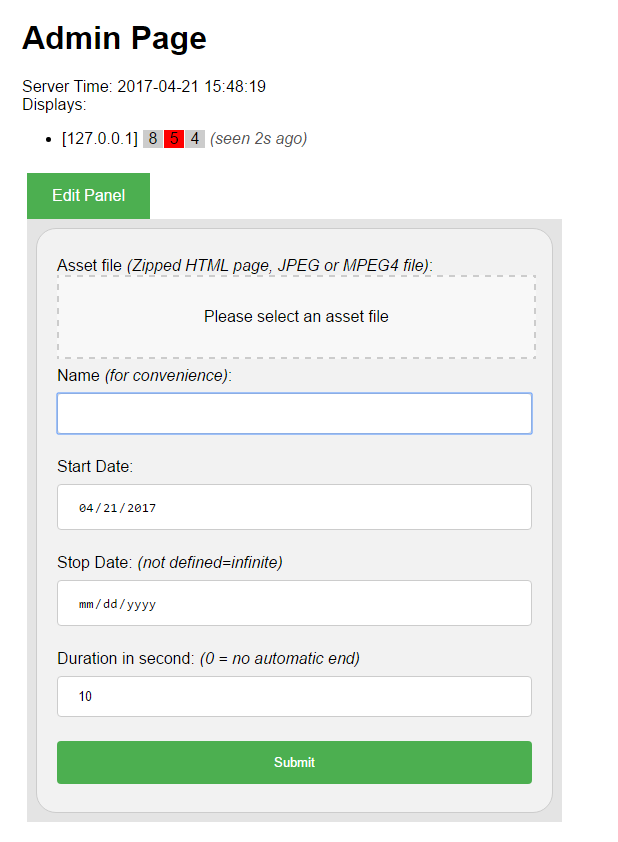Yet-Another-SlideShow, an open source solution for digital signage
- full versatile html5 slides (hence support images, videos, HTML5 animations, etc...)
- admin interface
- really simple to use: just drag'n drop your medias in the admin interface
- no installation needed (except the server), clients should only display a webpage
- supports multiples display's clients
- I want to make it very simple and free to use and share!
- I want to have a versatile slideslow, so here slides are actually html pages
- There is no transition between slides
- IE11/Edge doesn't work see 'How does it works' for more details.
- jpeg - for static image
- mp4 - for video
- zip - for html5 page
...and potentially much more, as far as full HTML5 is supported !
see 'docs\html5-clock.zip' to get an idea of what is achievable easily.
Note: for html5 page, the main one should be nammed 'page.html'
- Admin's page is here http://yourserver/admin
- Display's page is http://yourserver/display
A database with 2 tables is defined:
- assets table
- displays table
1-Assets table defines a list of assets (or 'slides') as follow:
- an id
- an optionnal asset name, for convenience.
- an optional start and stop date for 'scheduling' if you want to do a timeboxed campaign
- an optional duration
- a path to where the actual slide's HTML5 page is (page.html)
- a status (i.e. 'backstage', 'pending', 'live' or 'finished')
2- Displays table contains one row per Display (or client) Entries in this table are automatically added when new connections occurs.
We actually use a cookie (with an expiration date of 10 Years) to dinstiguish, if this connection is new or not.
The fields are:
- id, set by a cookie
- ip address, mainly for debug/status (note: this don't work if displays are behing a proxy)
- date, i.e. a kind of heartbit the see active displays
- current asset id showed by the display.
From there it's quite easy,
when clients/displays loads http://yourserver/display they are actually redirected on the next asset HTML5 page, by a pure HTTP/1.1 redirection as follow:
header('Location: '.$assetPath);
from there HTML5 pages are actually wrapped by the following HTTP header:
header("Refresh: timeInSec; url='http://yourserver/display', true, 303)
That implied, whatever occurs in the HTML page (even bugs ;)), clients will be redirected-back to http://yourserver/display after timeInSec seconds.
And this close the loop to be able to get a sequential process of HTML slides.
Actually it's important to notice that 'Refresh' is a Proprietary/non-standard HTTP header. However in 2017 more of less all browsers (Firefox, Chrome) supports it (it's a Netscape Legacy).
some refences about HTTP redirection here:
Note: for video, no duration (i.e. field set to 0) is needed, and a manual redirection is done by the HTML page itselft when the video is finished:
window.location.href = 'http://yourserver/display';
Nothing really complicate here, asset are read from the lastest inserted (throught the admin interface) to the oldest.
Only asset with 'LIVE' status are used.
define('STATUS_BACKSTAGE', 0);
define('STATUS_PENDING', 1);
define('STATUS_LIVE', 2);
define('STATUS_FINISHED', 3);
- BACKSTAGE means, that admin should validate it to make it live
- PENDING/FINISHED are related to asset startDate and endDate if defined
This repo use submodule, so don't forget:
git submodule update --init
Arborescence tree:
\admin - admin page
\display - display page (which should be load by display's client)
\setup - used only once for the page setup
\docs - various docs an sample
- git
- php5 with mcrypt extension
- mysql
Note: you may also have to update your upload filesize setting
example in php.ini:
post_max_size = 100M
upload_max_filesize = 100M
example in nginx.conf:
client_max_body_size 100M;
see the following note about Nginx Prequists
In your 'www/' folder, clone this repo with:
sudo git clone --recursive --branch release https://github.com/chtimi59/yass.git
then go to http://yourserver/yass/setup/ and follows the instructions, the process should end with the following prompt:
**Warning** The setup should ends with **" Congratulation! "**
At this point you should now have:
- http://yourserver/yass/admin/ Admin Interface
- http://yourserver/yass/ page to be load by displays
on Unix
sudo ./update.sh
on Windows
update.bat
See our FAQ


